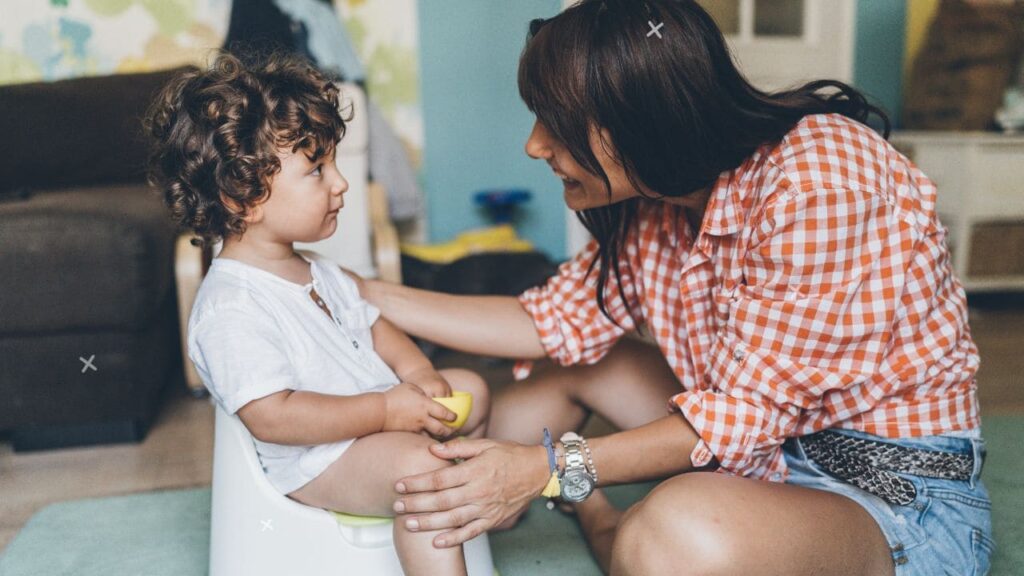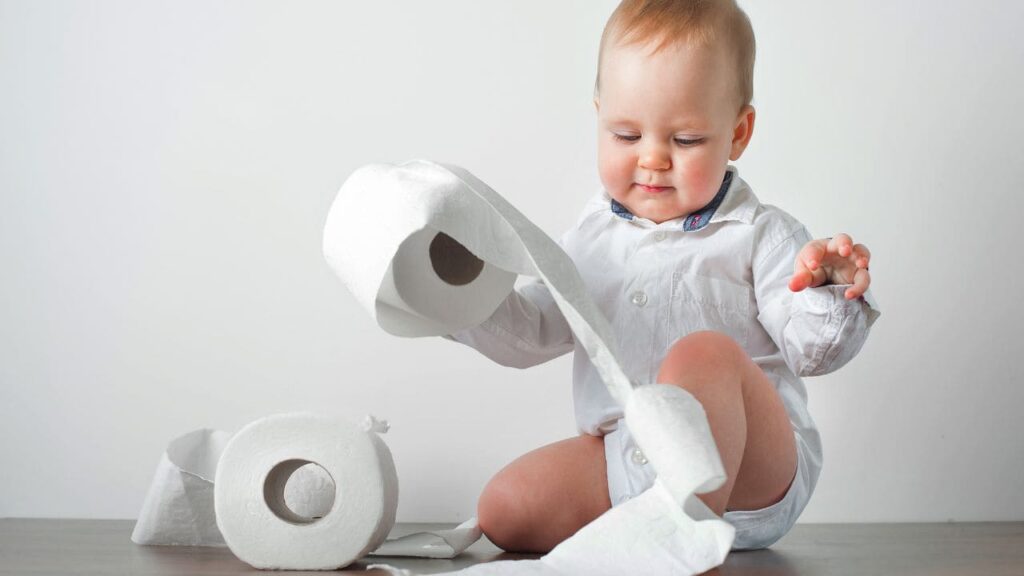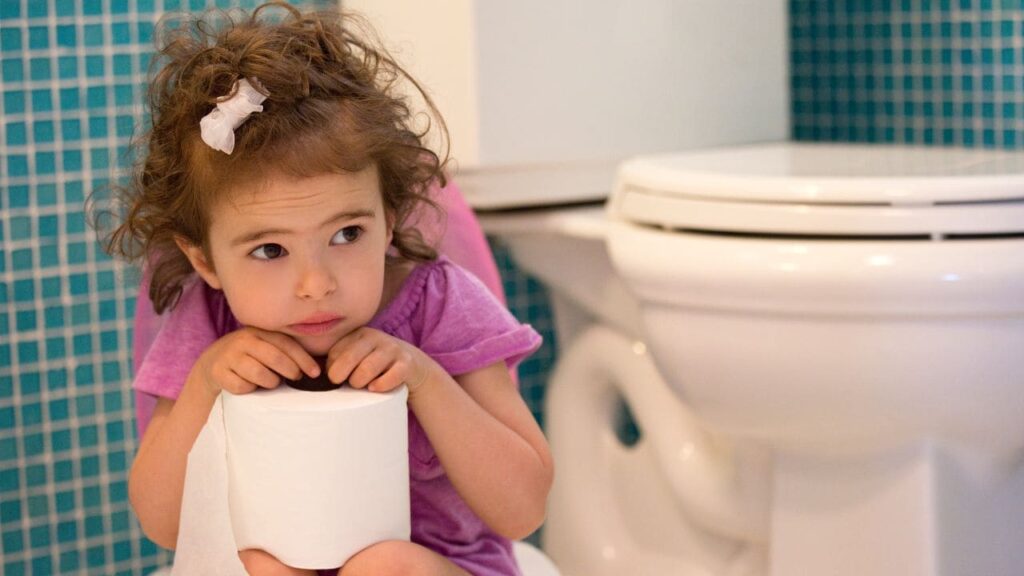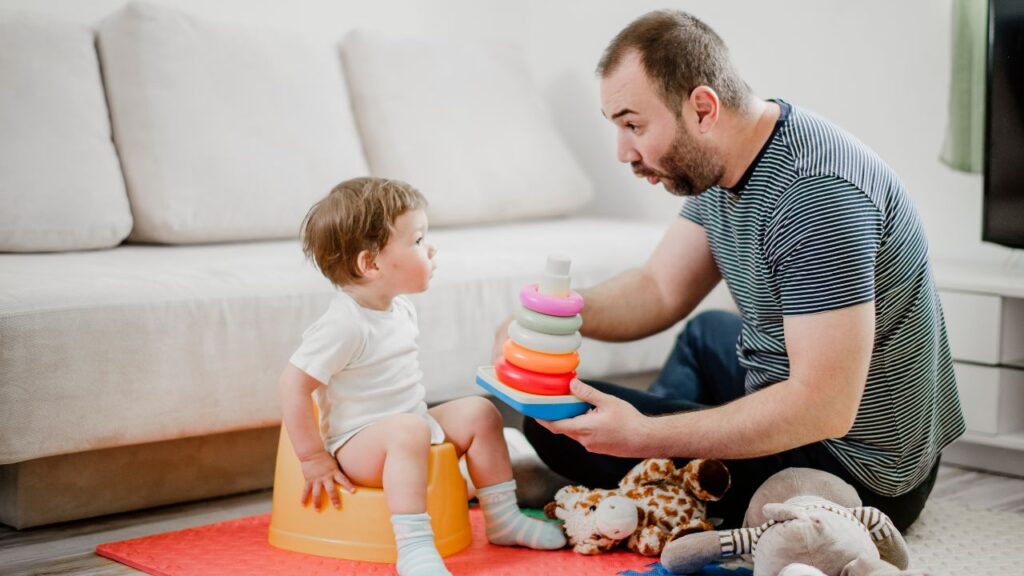As a parent, few toddler development milestones feel more exciting and liberating than when your toddler graduates out of diapers. But the truth is, potty training success depends entirely on starting when your child shows clear signs of readiness. Ignoring the signs your child is not ready for potty training and forcing the issue can spell disaster.
I learned this the hard way with my first daughter Amy. At 2 years old, she was doing fairly well with her numbers, letters, and speech. She seemed coordinated enough when throwing balls or pedaling her tricycle. So when a friend began gushing about her newly potty trained son, I figured it must be time to transition Amy from diapers too.
The next few weeks were filled with tears, accidents, sticker charts on the wall, and more than our fair share of frustration. Amy just didn’t seem to “get it”—and the more I pushed potty training, the more she resisted. It finally clicked for us both that she simply wasn’t ready yet. Once we backed off and tried again a few months later, responding to her eventual signs of readiness, she quickly got the hang of toilet training.
While every child meets this important potty learning milestone at their own pace, there are some common signs that signal it may be best to hold off on formal potty training for now. Here are the top 7 indicators that your toddler isn’t quite ready to transition from diapers along with the best ways to help nurture their readiness.
1. Your child has little to no interest in the potty
It starts with simple curiosity. Your toddler notices Dad leaving the bathroom, or older siblings taking potty breaks. This piqued interest eventually leads them to want a potty training of their very own—even if they simply sit on it fully clothed at first!
Lack of initiative here generally means forcing potty training won’t go well. But all is not lost. There are fun ways to spark potty enthusiasm on your child’s terms when they are more receptive:
- Let them pick out fun underwear designs or help decorate their potty chair
- Read engaging potty-themed books together
- Watch fun potty training videos that model the process
- Casually talk about what potties are used for without pressure
- Lead by example and invite them to imitate your habits
- Consider peer power—seeing friends use the potty can motivate them
Get creative, stay upbeat, and let toilet training interest happen organically. Their curiosity and initiative will kick in eventually.

2. Your toddler is unable to reliably communicate their need to go
Consistent potty training success relies heavily on your child’s ability to self-recognize impending pees and poos with enough time to get themselves to their little toilet. Being tuned into their body’s signals and then articulating that need either verbally or nonverbally is essential.
Trouble identifying an imminent bathroom need points clearly to an underdeveloped awareness and potty readiness. While frustrating, don’t lose hope. There are constructive things you can do to foster this understanding:
- Pay attention to their typical “going” patterns and cues so you can prompt preemptively
- Note timing of meals, naps, activities to predict likely urge times
- Use proper anatomy terms clearly so cues translate between you
- Have them practice identifying and declaring a variety of needs
- Try sign language or gesture cues if speech isn’t clear yet
Equipping your little one with the ability to recognize and express their body’s urges gets you well on your way to underwear success.
| Physical Cues | Behavioral Cues | Verbal Cues |
|---|---|---|
| Knee bouncing | Trying to hold privates | “Need to go!” |
| Squatting or standing with legs crossed | Pacing, hiding, or squirming | ”My pee-pee hurts!” |
| Grabbing or holding crotch area | Sudden stillness | “Poop coming” |
| Grunting, or straining face | Attempting to hold urine or BMs | ”Belly ache” |
3. Wet or dirty diapers don’t seem to bother your toddler
When children remain content to sit in their soiled or drenched diapers for long stretches, it’s a red flag that their readiness to leave those dependable old diapers behind remains low. Discomfort, after all, is often a motivating impetus for change.
Pressing forward with potty training under these conditions not only fuels unnecessary messes but also teaches your toddler that you don’t actually mean it when you tell them that “big kids use the potty.” Mixed signals like these undermine the entire process.
While staying the course, you can help coax potty readiness along by:
- Allowing their awareness to unfold naturally without overprompting or negative reactions to accidents
- Giving timed potty reminders to help prevent excessive soilage
- Trying cotton training pants to allow more wetness sensation
- Enlisting nighttime-only diapers to allow waking with wetness that promotes awareness
- Dressing them in bulkier disposable diapers occasionally to offset comfort
Meeting your child where they’re at developmentally prevents power struggles while nurturing comprehension.

4. Your toddler is having frequent bowel/bladder accidents
When youngsters have very little conscious control over their elimination functions, it creates perpetual uncertainty and many misses (not to mention mountains of laundry). Sporadic bowel movements, sudden gushes while playing, trouble “holding it,” or not finishing before their stream starts can all point to physical immaturity.
Neurological connections enabling bladder and bowel control continue maturing between ages 2 and 4. Unpredictable bathroom functions equate to underdeveloped readiness for successful toilet training consistency. Have patience. There are still constructive steps forward:
- Track patterns in a potty journal to establish a helpful routine
- Familiarize yourself with digestive timetables and warning signs like fidgeting
- Schedule practice runs by timing trips to coincide with their likely urge times
- Use reading, songs or calming breaths while seated to develop focus
- Watch for physical cues and respond promptly to avoid pressing their limits
- Try prompts but let them guide process to avoid power struggles
Equipping them with basic potty awareness tools now allows their nervous system to eventually catch up.
5. Your little one has trouble sitting still or focusing even briefly
Real talk—successful potty training requires your tot to regularly pause adventures, tamp down squirminess, and concentrate on the task at hand even when their toddler brain screams GO. This impulse control and patience doesn’t come naturally to all youngsters.
If your kiddo bolts off the potty mid-stream or has a tantrum when you suggest a potty break, it likely means that their neurological development isn’t quite there yet. Both attention span and impulse control continue maturing between ages 3-4.
In the meantime try engaging their excitement in constructive ways:
- Make proper potty posture fun by allowing books, music or special toys
- Practice “quick potty” with a timer and race against the beeps
- Take the potty outside for a change of scenery
- Role model relaxation techniques like deep breaths
- Positively reinforce any attempt at patient sitting
Strengthening their attention incrementally today establishes critical skills for consistent toilet training results later. Meeting them where they currently are developmentally reduces everyone’s frustration.
Focus-Building Activities
| Gross Motor | Fine Motor | Social-Emotional |
|---|---|---|
| Running obstacle courses | Lacing cards | Roleplaying routines |
| Jumping games like Hopscotch | Sorting beads into containers | Singing interactive songs |
| Balancing practice | Doing buckles and zippers | Playing “Follow the Leader” |
| Catching & throwing balls | Stringing links or pasta | Practicing turntaking games |

6. Your child gets unusually anxious, defiant, or emotional about using the potty
Toddlers thrive on familiarity, autonomy, and knowing exactly what comes next. When they perceive that potty training jeopardizes this sense of security or control, emotional distress responses often emerge ranging from nail biting and Legos chucking to full meltdowns.
Big reactions suggest forcing functions that exceed current capabilities. Their fears may even stem from past accidents, harsh reactions, or transitions still ongoing. Tensions invariably boil over into the process if not first addressed compassionately.
Pressing forward with potty training regardless risks severe power struggles and negative associations forming. Instead hit pause, offer affectionate reassurance, and try the following potty training stress reducers:
- Allow them to observe without pressure before participating
- Schedule extra toddler snuggles as an outlet for uncertainty
- Read potty books portraying calm confidence and success
- Give them choices to boost their sense of ownership
- Remind them there’s no need to rush—it will happen when their body is ready
- Follow their pace letting them guide next steps
With stresses minimized and security restored, cooperation naturally improves.
7. Your child is facing major disruptions to their routine
Changes big or small easily throw developing toddlers for a loop interfering with natural development, as my daughter can attest. Potty training success depends heavily on stability, consistency, and minimizing life chaos wherever possible during the initial transition.
Major schedule disruptions like:
- Family trips or holidays
- Daycare transitions
- A move or home renovation
- New siblings in the home
- Parental job changes or separations
Can understandably derail both physiology and focus from showing potty progress. When considering optimal timing, ensure your calendar allows for consistency in those early weeks and months.
If an unexpected disruption creeps up mid-stream causing accidents or standstill, simply pause training attempts until equilibrium returns. Their potty readiness signs will reemerge once they’ve adjusted to the “new normal” disruption free.
| Preparation Phase | During Disruption | Regroup & Reassess |
|---|---|---|
| Set realistic expectations | Offer empathy & emotional connection first | Allow adjustment period after disruption passes |
| Develop communication tools | Provide additional cuddles/support | Observe renewed interest and capability signs |
| Build up focus stamina ahead | Keep familiar anchors & routines | Restart training with small steps backed up |
| Establish solid bladder control baseline | Use diapers to alleviate added pressure | Expect some backslides as they reacclimate |
| Minimize household stressors where possible | Reassure this is temporary, they are safe | Regain consistency week+ before moving forward again |

Additional Challenges to Potty Training Success
Beyond the key signs above, there are a few other common hurdles that can temporarily obstruct potty training readiness skills from emerging:
Constipation Problems
If your child is struggling with constipation, the discomfort, pain, and fear of bowel movements understandably deters potty training progress. Getting constipation relief should be the priority before attempting to train. Some helpful constipation tips:
- Increase daily fiber and water intake
- Add probiotic foods to support healthy gut flora
- Ensure diet includes digestion-friendly fats
- Try daily tummy massages to stimulate bowel movement
- Discuss kid-friendly laxatives if needed to get back on track
Once your child finds normalcy and relief again, the confidence will return too.
Physical Limitations
Fine and gross motor skill development varies greatly from child-to-child. If your toddler lacks the dexterity to manipulate clothing, get stabilized on the potty, or move between bathroom transitions, it will significantly obstruct the process. Focus first on building physical abilities through games and activities before expecting potty independence.
Additionally, some children have sensory issues, nervous system differences, or special needs that require occupational therapy assistance when developing pottying skills. Seeking professional support guides you in best accommodating their unique needs. Patience and compassion is key.
Major Family Stress
It likely comes as no surprise that big familial disruptions like a recent move, new sibling arrival, parental job loss, divorce proceedings, or grief negatively impact a toddler’s ability to focus on new skills. However, during times of significant upheaval or uncertainty, children instinctively revert to the familiarity and comfort of diapers. Meeting them with empathy first while reestablishing stability lays the foundation for future success.
While every child arrives at potty training readiness differently, these 7 signs provide helpful insight on when to pause and reset expectations. Refocusing your efforts on nurturing the prerequisite skills they still lack encourages organic awareness when the time is right. Meeting them where they’re at developmentally prevents many tears and standoffs down the road—helping potty training live up to its promise once achieved.
We all want to celebrate our tidy toddler’s independence from diapers sooner than later. But respecting their unique toilet training process prevents power struggles and supports self-confidence. With a dollop of patience and a sprinkle of fun, their readiness will shine through right on time.
FAQ – 7 Signs Your Child is Not Ready for Potty Training and How to Help Them
What are some signs my toddler is ready to start potty training?
Signs of readiness include showing interest in the potty, keeping a diaper dry for extended periods of time, demonstrating understanding of bodily functions, indicating need to go, and possessing the necessary physical abilities like balance and dexterity. Most kids show a majority of these signs between ages 2-4.
My toddler was doing well with pee training but is now having frequent accidents. What should I do?
It’s common for kids to progress in fits and starts. Accidents after a period of success usually just indicate normal backsliding. Stay positive, revert back to frequent potty breaks, watch for signals, prompt gently after meals/naps, and consider backing off expectations temporarily until skills re-stabilize avoiding power struggles.
I worry my strong-willed toddler will refuse to potty train. What’s the best approach?
It’s key to keep the process lighthearted versus rigid. Offer choices like sticker charts as incentive, use favorite characters in books/videos to model skills, set up potty races and games, and follow their cues resisting control battles. Meeting them with empathy, humor and options can achieve more willing cooperation.
My child has recently faced major disruptions with a move and new daycare. How can I tell if accidents mean they are not ready?
Regressions are very normal during transitions when routines are disrupted. Support and reconnect emotionally first, then re-establish consistency in schedules. Observe over the next month after changes stabilize for renewed readiness signs. It’s OK to wait if acting out or accidents persist once initial upheaval passes.
How do I know when to try potty training again after a failed prior attempt?
Use the 7 key readiness signs as your guide. Have those indicators like bladder control, focus, awareness, interest and communication skills emerged more dependably on their own first? Can your child demonstrate comprehension of the concept? If you are still needing to prod and no progress resumes after 2-3 months of backing off pressure, it likely still means more development is needed.











